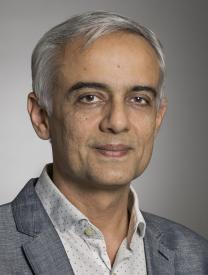- Fellow, American Physical Society
- Scientific Editor, Galaxies and Cosmology, The Astrophysical Journal (2017-2020)
- Co-coordinator, DES Weak Lensing Working Group (2007-2016)
- Co-chair, LSST Weak Lensing Science Collaboration (2006-2013)
- Advisory Board and Management Committee of the DES project (current) and LSST project (2006-2010)
- Edmund J. and Louise W. Kahn Term Chair in the Natural Sciences (2011-2015)
- Spokesperson, LSST Dark Energy Science Collaboration (2012-2015)
Ph.D., MIT (1994)
A.B., Physics (High Honors), Princeton University (1989)
My research area is cosmology, gravitational lensing and machine learning in astronomy. The questions I study are: How did small fluctuations in the early universe grow to form the large-scale structure observed today? What is the nature of dark matter and dark energy? And how did these mysterious components of our universe shape the formation of galaxies and clusters? A brief description follows; for details see my publications listed below.
Lensing and cosmology with galaxy surveys:
Gravitational lensing is the shearing and magnification of light we receive from distant galaxies. I use ‘weak’ lensing, the small distortions in the shapes of millions of galaxies, to map the large-scale distribution of dark matter and address cosmological questions.
I have been involved in the Dark Energy Survey (DES) and in the planning of the Large Synoptic Survey Telescope (LSST) and the space missions Euclid and Roman. My research group members have carried out lensing measurements and cosmological analyses with DES. Cross-correlations of galaxies and stars with the cosmic microwave background (CMB) is a promising new field of cosmology. We have worked on cosmology and galaxy clusters with DES and the CMB surveys ACT and SPT, and look forward to the Simons Observatory.
Cosmologists have been intrigued recently by puzzles related to the current expansion rate of the universe (called H0) and the growth of cosmic structures: direct measurements appear to disagree with the predictions of the standard model of cosmology anchored by the early universe. My group’s work with weak lensing is aimed at sharpening the measurement of large-scale structure. I have also worked on both the theory and data sides of the H0 puzzle.
Data Science and AI: Astrophysics Research and Penn’s Data Driven Discovery Initiative:
In the present era of big data astronomy, exciting advances have been made by applications of statistics and machine learning. My group has worked on topics that range from deep learning approaches to deblending galaxy images to cosmological inference in high dimensions. I am interested in the question: what is all the available information in cosmological maps and how can we optimally extract it to test theoretical models. I have also developed courses on the applications of statistics and machine learning to the natural sciences with my colleagues Masao Sako and Mike Jarvis, and organized fun data science activities for summer undergraduate students at Penn.
Since Fall 2021, I have co-directed the Data Driven Discovery Initiative at Penn’s School of Arts and Sciences. We have launched programs that span the physical, biological and social sciences, including a postdoctoral fellows program, Data Science for Social Good and the SAS data science minor.
Galaxy Clusters and Small Scales:
Galaxy clusters are the largest relaxed structures in the universe. A basic question about clusters has vexed cosmologists for decades: what is the boundary of their dark matter ‘halo’?
On smaller scales, I have explored how outer parts of planetary systems can be detected and studied statistically with large surveys. We have constrained debris disks and Oort clouds around nearby stars via their thermal emission using CMB survey data and explored the detection of Planet 9 with forthcoming surveys. We have analyzed survey data to identify a feature called splashback which marks the cluster halo boundary and provides a promising new probe of both galaxy evolution and fundamental physics.
Astrophysical Tests of Gravity:
Theories of modified gravity aim to explain cosmic acceleration without invoking dark energy. In addition to their cosmological effects, these theories typically predict new physical effects on the smaller scales of individual galaxies and clusters. Possible dark matter interactions also lead to signatures on small scales. My group has developed astrophysical tests of gravity and dark sector interactions, and used multi-wavelength datasets to constrain theoretical models.
Research Group:
I am fortunate to work with a wonderful group of colleagues. At Penn, the graduate students and postdocs I co-advise are: Shubh Agrawal, Rafael Gomes, Minsu Park, Kunhao Zhong, Marco Gatti and Meng-Xiang Lin.
Recent alumni from my group, including undergraduate, graduate and postdocs and their current institutions (in reverse chronological order):
2023: Tanvi Karwal (Chicago), Dimitrios Tanoglidis (AI industry), Sarah Kane (Cambridge)
2022: Marco Raveri (Genoa faculty), Cyrille Doux (Grenoble faculty), Shivam Pandey (Columbia), Tara Dacunha (Stanford), Eli Wiston (Berkeley)
2021: Lucas Secco (Chicago), Tae-Hyeon Shin (Stonybrook), Matt Belyakov (Caltech), Sam Goldstein (Columbia)
2020: Eric Baxter (Hawaii faculty), Jeremy Sakstein (Hawaii faculty), Jake Nibauer (Princeton)
Astro 006: The Solar System, Exoplanets, and Life
Astro 211: Introduction to Astrophysics I
Astro 212: Introduction to Astrophysics II
Phys 359: Data Analysis for the Natural Sciences II: Machine Learning
Physics 503: General Relativity
Physics 533: Topics in Cosmology
Biology/Physics 566: Graduate Seminar — Machine Learning Methods In Natural Science

